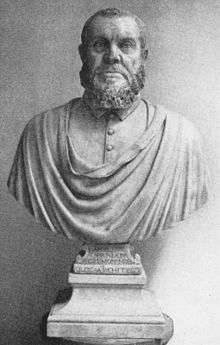Juanelo Turriano
Juanelo Turriano (Italian: Gianello Torriano; born Giovanni Torriani, c. 1500 — 1585) was an Italo-Spanish clockmaker, engineer and mathematician. He was born in Cremona.
Juanelo Turriano | |
|---|---|
 Bust of Juanelo Turriano | |
| Born | Giovanni Torriani 1500 |
| Died | 1585 |
| Resting place | Toledo, Spain |
Called to Spain in 1529 by Charles V, Holy Roman Emperor, he was appointed Court Clock Master and built the Cristalino, an astronomical clock that made him famous in his time. Philip II of Spain named him Matemático Mayor. He worked and lived in Toledo, where he built the Artificio de Juanelo, an engine that, driven by the river itself, lifted water from the Tagus to a height of almost 100 meters, to supply the city and its castle (Alcázar).
Turriano is attributed as the creator of the "Clockwork Prayer", an automaton representing a monk manufactured in the 1560s based on a commission from Philip II of Spain.[1][2] Following the recovery of his son, and in the belief that Didacus of Alcalá had in some way intervened on his behalf, King Philip II of Spain commissioned Juanelo Turriano, mechanic to Emperor Charles V, to build a clockwork model of Didacus. The model would perform a number of set actions, including the beating of the breast which accompanies the Mea culpa prayer. An automaton of similar age, functions, and appearance is in the collections of the National Museum of American History, Smithsonian Institution]. [3] [4]
Another automaton associated with Turriano is a figure of a lady playing a lute housed in the Kunsthistorisches Museum, Vienna.[1][5]
He died at Toledo in 1585.
Bibliography
- Zanetti, Cristiano. Janello Torriani and the Spanish Empire: A Vitruvian Artisan at the Dawn of the Scientific Revolution. Brill, 2017.
References
- King, Elizabeth. "Clockwork Prayer: A Sixteenth-Century Mechanical Monk". Retrieved 2011-06-18.
- "A Clockwork Miracle". Retrieved 2011-06-18.
- "Smithsonian Institution collections listing".
- King, Elizabeth (Spring 2002). "Clockwork Prayer: A Sixteenth-Century Mechanical Monk". Blackbird. 1 (1).
- ed. by Martin L. Davies (2003). Breaking the disciplines : reconceptions in knowledge, art and culture. London [u.a.]: Tauris. ISBN 9781860649172.CS1 maint: extra text: authors list (link)
- This article is mostly translated from the longer Spanish language article.